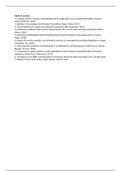Summary
Summary papers AAIS
- Course
- Institution
Samenvatting van alle papers voor jaar . Table of content 1. A design science research methodology and its application to accounting information systems research (Geerts, 2011) 1. Big Data in Accounting: An Overview (Vasarhelyi, Kogan, Tuttle, 2015) 2. Toward Blockchain-based accounting and assura...
[Show more]



